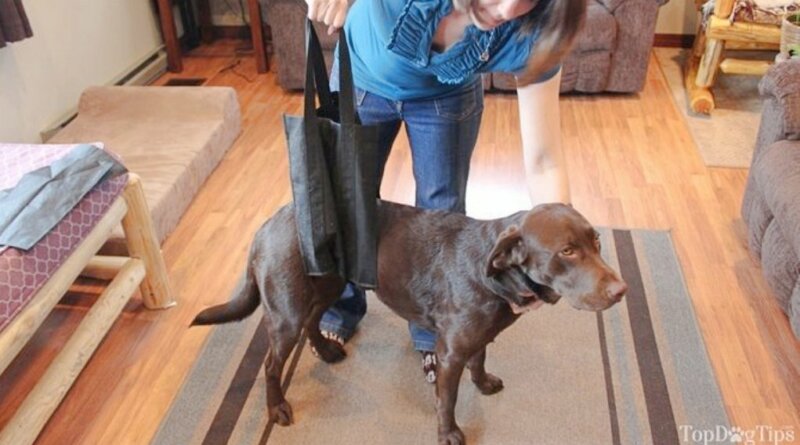How To Make A Dog with a Slipped Disc Comfortable – Top Dog Tips
A slipped disc in dogs, more formally known as intervertebral disc disease (IVDD), is the most common reason for the appearance of paralysis in dogs. Some breeds are more susceptible than others, and dogs with certain previous health issues could be more likely to develop IVDD. Knowing how to make a dog with a slipped disc comfortable is imperative if your dog is diagnosed with this condition.
IVDD is an ailment in which the supporting discs between the vertebrae bulge or rupture into or around the spinal cord. These discs ultimately put pressure on the nerves running through the spinal cord, causing pain, nerve damage, and other maladies.
IVDD is extremely common in chondrodystrophic breeds, or dogs whose normal cartilage development has been altered through generations of breeding to get a stout, usually shorter appearance. Examples of these breeds include dachshunds, beagles, bulldogs, corgis, pugs, basset hounds, and poodles.
IVDD is not exclusive to these breeds, and disc degeneration can be present in dogs as young as six to twelve months. Other symptoms of IVDD include:
- pain or stiffness in the back or neck
- change in stance or posture (often an arched or hunched back)
- lack of coordination
- impairment or complete lameness in one or more limbs
- reluctance to walk, rise, or play
- sudden general weakness when moving
- loss of bladder control
Should you notice one or more IVDD symptoms in your pup, get him evaluated by your veterinarian as soon as possible. Left untreated, IVDD can lead to disc rupture, increased pain, and even paralysis. Even when treated, IVDD can have lifelong effects, so consistent care is critical.
Once diagnosed by your vet, knowing how to make a dog with a slipped disc comfortable is a necessity. Your veterinarian should be able to guide you in this process, and the following tips and tricks may be of use too.
How To Make A Dog with a Slipped Disc Comfortable

A neurological exam may be necessary, which would include an X-ray with dye contrast, myelography, MRI (magnetic resonance imaging), and CT scan (computed tomography). These tests will determine the level of your dog’s spinal cord damage.
In some cases, taking a sample of the dog’s cerebral spinal fluid will be necessary to exclude an infection. Your veterinarian will be able to walk you through the necessacy procedures before beginning any testing.
Medication & Surgery
Depending on the severity of the damage, your veterinarian may prescribe medication or recommend surgery. It is most likely that your vet will prescribe pain relievers and non-steroidal anti-inflammatory (NSAID) drugs to cure the infection.
If your dog suffers from more than one slipped disc, surgery is usually the only option to solve the issue. Since it is most effective within the first two days after the injury, it is crucial that you take the dog to the vet as soon as you notice a problem.
Give Him Quiet Time
Depending on the severity of your dog’s spinal injury, restricting his movement for at least four to six weeks is highly recommended. The best option is to keep your pup confined to a dog crate to reduce the chances of sudden movements that could make his condition worse.
If you don’t want to kennel your dog, you can provide him with his own space another way. Small breeds can be confined with a puppy playpen or you could give your large breed dog a room of his own. Just be sure the area is safe for you dog, with no stairs or high furniture to climb on.
MORE: 6 Best Dog Sling Harnesses fo Walking Support
 Physical Therapy
Physical Therapy
Physical therapy has the same benefit for pets as it does for humans. You may be able to do some physical therapy exercises with your dog at home. Your veterinarian may share some possible exercises that your dog is capable of. They may also refer you to a veterinary rehab facility or a veterinary physical therapist.
Massage, hydrotherapy and stretching could be recommended for your dog. The therapy will be dependent upon your dog’s overall health, the severity of the condition and whether or not your dog requires surgery.
Manage His Weight
If your dog is carrying around extra weight, it is extremely bad for his back. The added weight creates more pressure and stress on his spine. If your dog is overweight, it is imperative that you help him lose the weight as soon as possible.
For more information on the dangers of obesity in dogs and how to help your dog lose weight, these resources will help:
Rear Leg Sling
Using a dog sling helps you to support and stabilize your pet’s hind end. These slings wrap under your dog’s belly and up over his back. You can see an example in the photo above. The long handles allow you to help lift your dog and take some of the weight off of his back and legs.
You can purchase rear leg slings or make your own DIY sling. These products may take some getting used to, but eventually your dog will realize that the sling is helping him. Because the sling is made of a soft material, it won’t cause him any discomfort. Just be sure to use gentle pressure, and do not pull up too aggressively.
READ NEXT: Slipped Disc in Dogs – Causes and Treatment





